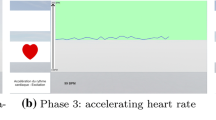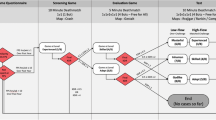Abstract
Flow experience is often considered as an important standard of ideal user experience (UX). Till now, flow is mainly measured via self-report questionnaires, which cannot evaluate flow immediately and objectively. In this paper, we constructed a physiological evaluation model to evaluate flow in virtual reality (VR) game. The evaluation model consists of five first-level indicators and their respective second-level indicators. Then, we conducted an empirical experiment to test the effectiveness of partial indicators to predict flow experience. Most results supported the model and revealed that heart rate, interbeat interval, heart rate variability (HRV), low-frequency HRV (LF-HRV), high-frequency HRV (HF-HRV), and respiratory rate are all effective indicators in predicting flow experience. Further research should be conducted to improve the evaluation model and conclude practical implications in UX and VR game design.

Similar content being viewed by others
References
Zaharias P, Mehlenbacher B (2012) Exploring User Experience (UX) ind virtual learning environments. Int J Hum Comput Stud 70(7):475–477
Hassenzahl M, Tractinsky N (2006) User experience—a research agenda. Behav Inf Technol 25(2):91–97
Csikszentmihalyi M (1990) Flow: the psychology of optimal experience. Harper & Row, New York
Csikszentmihalyi M (1975) Beyond boredom and anxiety: experiencing flow in work and play. Jossey-Bass, San Francisco
Sweetser P, Wyeth P (2005) GameFlow: a model for evaluating player enjoyment in games. Comput Entertain 3(3):1–24
Jegers K (2007) Pervasive game flow: understanding player enjoyment in pervasive gaming. Comput Entertain 5(1):9
Berta R, Bellotti F, De Gloria A, Pranantha D, Schatten C (2013) Electroencephalogram and physiological signal analysis for assessing flow in games. IEEE Trans Comput Intell AI Games 5(2):164–175
Tozman T, Magdas ES, MacDougall HG, Vollmeyer R (2015) Understanding the psychophysiology of flow: a driving simulator experiment to investigate the relationship between flow and heart rate variability. Comput Hum Behav 52:408–418
Harmat L, de Manzano Ö, Theorell T, Högman L, Fischer H, Ullén F (2015) Physiological correlates of the flow experience during computer game playing. Int J Psychophysiol 97(1):1–7
Shin D-H, Biocca F, Choo H (2013) Exploring the user experience of three-dimensional virtual learning environments. Behav Inf Technol 32(2):203–214
Engeser S (2012) Advances in flow research. Springer, Verlag, New York
Goleman DJ (1995) Emotional intelligence. Bantam, New York
Marr AJ (2001) In the zone: a biobehavioral theory of the flow experience. Athletic insight. Online J Sport Psychol 3(1). Elektronische Ressource: http://www.athleticinsight.com/Vol3Iss1/Commentary.htm
Dietrich A (2003) Functional neuroanatomy of altered states of consciousness. The transient hypofrontality hypothesis. Conscious Cogn 12(2):231–256
Rheinberg F (2008) Intrinsic motivation and flow experience. In: Heckhausen H, Heckhausen J (eds) Motivation and action. Cambridge University Press, Cambridge, pp 323–348
Peifer C, Schulz A, Schächinger H, Baumann N, Antoni CH (2014) The relation of flow experience and physiological arousal under stress—can u shape it? J Exp Soc Psychol 53:62–69
de Manzano O, Theorell T, Harmat L, Ullén F (2010) The psychophysiology of flow during piano playing. Emotion 10(3):301–311
Fairclough SH (2009) Fundamentals of physiological computing. Interact Comput 21(1–2):133–145
Rani P, Sarkar N, Liu C (2005) Maintaining optimal challenge in computer games through real-time physiological feedback. Paper presented at the 11th Human–Computer Interaction International, Las Vegas, NV
Prinzel LJ, Freeman FG, Scerbo MW, Mikulka PJ, Pope AT (2000) A closed-loop system for examining psychophysiological measures for adaptive task allocation. Int J Aviat Psychol 10(4):393–410
Schüler J, Engeser S (2009) Incentives and flow experience in learning settings and the moderating role of individual differences. In: Wosnitza M, Karabenick SA, Efklides A, Nenninger P (eds) contemporary motivation research: from global to local perspectives. Hogrefe, Göttingen, pp 339–358
Csikszentmihalyi M, LeFevre J (1989) Optimal experience in work and leisure. J Personal Soc Psychol 56(3):815–822
Moneta GB, Csikszentmihalyi M (1996) The effect of perceived challenges and skills on the quality of subjective experience. J Personal 64:275–310
Takatalo J (2008) Components of human experience in virtual environments. Comput Hum Behav 24:1–15
Takatalo J, Kawai T, Kaistinen J (2015) User experience in 3d stereoscopic games user experience in 3D stereoscopic games. No. August 2015
Hwang M-Y, Hong J-C, Hao Y, Jong J-T (2011) Elders’ usability, dependability, and flow experiences on embodied interactive video games. Educ Gerontol 37(8):715–731
Cheng LK, Chieng MH, Chieng WH (2014) Measuring virtual experience in a three-dimensional virtual reality interactive simulator environment: a structural equation modeling approach. Virtual Real 18(3):173–188
Phillips L, Interrante V, Kaeding M (2012) Correlations between physiological response, gait, personality, and presence in immersive virtual environments. Presence Teleoper Virtual Environ 21(2):119–141
Hamilton JA, Haier RJ, Buchsbaum MS (1984) Intrinsic enjoyment and boredom coping scales: validation with personality, evoked potential and attention measures. Personal Individ Differ 5(2):183–193
Dietrich A (2004) Neurocognitive mechanisms underlying the experience of flow. Conscious Cogn 13(4):746–761
Austin JH (2010) The thalamic gateway: how the meditative training of attention evolves toward selfless transformations of consciousness. In: Bruya B (ed) Effortless attention: a new perspective in the cognitive science of attention and action. MIT Press, Cambridge
Davis CA, Levitan RD, Reid C, Carter JC, Kaplan AS, Patte KA et al (2009) Dopamine for ‘wanting’ and opioids for ‘liking’: a comparison of obese adults with and without binge eating. Obesity 17(6):1220–1225
Goldberg II, Harel M, Malach R (2006) When the brain loses its self Prefrontal inactivation during sensorimotor processing. Neuron 50:329–339
Gusnard DA, Akbudak E, Shulman GL, Raichle ME (2001) Medial prefrontal cortex and self-referential mental activity: relation to a default mode of brain function. Proc Natl Acad Sci USA 98:4259–4264
Raichle ME, MacLeod AM, Snyder AZ, Powers WJ, Gusnard DA, Shulman GL (2001) A default mode of brain function. Proc Natl Acad Sci USA 98:676–682
Sheikholeslami C, Yuan H, He EJ, Bai X, Yang L, and He B (2007) A high resolution EEG study of dynamic brain activity during video game play. In: Proceedings of 29th annual international conference IEEE Engineering in Medicine and Biology Society, pp 2489–2491
de Manzano Ö, Cervenka S, Jucaite A, Hellenäs O, Farde L, Ullén F (2013) Individual differences in the proneness to have flow experiences are linked to dopamine D2-receptor availability in the dorsal striatum. Neuroimage 67:1–6
Peifer C, Schachinger H, Baumann N, Schulz A, Antoni CH (2010) The relation of the stress-hormone cortisol and the flow-phenomenon. In: The concept of flow: toward a scientific integration, Braunschweig
Keller J, Bless H, Blomann F, Kleinbohl D (2011) Physiological aspects of flow experiences: skills-demand-compatibility effects on heart rate variability and salivary cortisol. J Exp Soc Psychol 47(4):849–852
Peifer C, Schachinger H, Antoni CH (2011) Cortisol and flow experience—an experimental approach. Paper presented at the 2nd world congress on positive psychology, Philadelphia, July, 2011
Peifer C, Schächinger H, Engeser S, Antoni CH (2015) Cortisol effects on flow experience. Psychopharmacology 232(6):1165–1173
Larsen JT, Berntson G, Poehlmann KM, Ito TA, Cacioppo JT (2008) The psychophysiology of emotion. In: Lewis M, Haviland-Jones JM, Barrett LF (eds) The handbook of emotions, 3rd edn. Guilford, New York
Kivikangas JM (2006) Psychophysiology of flow experience: an explorative study. Master’s thesis, University of Helsinki
Nacke LE, Lindley CA (2010) Affective ludology, flow and immersion in a first-person shooter: measurement of player experience. J Can Game Studies Assoc 3(5):1–21
Keller J, Bless H, Blomann F, Kleinböhl D (2011) Physiological aspects of flow experiences: skills–demand–compatibility effects on heart rate variability and salivary cortisol. J Exp Soc Psychol 47:849–852
Bruya B (2010) Effortless attention: a new perspective in the cognitive science of attention and action. MIT Press, Cambridge
Peifer C (2012) Psychophysiological correlates of flow experience. In: Engeser S (ed) Advances in flow research, ch 8. Springer, New York, pp 139–165
Fridlund AJ, Cacippo JT (1986) Guidelines for human electromyographic research. Psychophysiology 23(5):567–589
Larsen JT, Berntson GG, Poehlmann KM, Ito TA, Cacioppo JT (2008) The psy- chophysiology of emotion. In: Lewis M, Haviland-Jones JM, Barrett LF (eds) The handbook of emotions, 3rd edn. Guilford, New York
Van Boxtel A, Jessurun M (1993) Amplitude and bilateral coherency of facial and jaw-elevator EMG activity as an index of effort during a two-choice serial reaction task. Psychophysiology 30(6):589–604
Porges SW (1995) Cardiac vagal tone: a physiological index of stress. Neurosci Biobehav Rev 19(2):225–233
Uijtdehaage SH, Thayer JF (2000) Accentuated antagonism in the control of human heart rate. Clin Auton Res 10(3):107–110
Lehrer P (2003) Applied psychophysiology: beyond the boundaries of biofeedback. (Mending a wall, a brief history of our field, and applications to control of the muscles and cardiorespiratory systems). Appl Psychophysiol Biofeedback 28(4):291–304
Redondo M, Del Valle-Inclán F (1992) Decrements in heart rate variability during memory search. Int J Psychophysiol 13(1):29–35
Thayer JF, Hansen AL, Saus-Rose E, Johnsen BH (2009) Heart rate variability, prefrontal neural function, and cognitive performance: the neurovisceral integration perspective on self-regulation, adaptation, and health. Ann Behav Med 37(2):141–153
Kilpatrick DG (1972) Differential responsiveness of two electrodermal indices to psychological stress and performance of a complex cognitive task. Psychophysiology 9(2):218–226
Siddle DA, Lipp OV, Dall P (1996) The effects of task type and task requirements on the dissociation of skin conductance responses and secondary task probe reaction time. Psychophysiology 33(1):73–83
Tarvainen MP, Niskanen JP, Lipponen JA, Ranta-aho PO, Karjalainen PA (2014) Kubios HRV—heart rate variability analysis software. Comput Methods Progr Biomed 113:210–220
Welch KC, Lahiri U, Liu C, Weller R, Sarkar N, and Warren Z (2009) An affect-sensitive social interaction paradigm utilizing virtual reality environments for autism intervention. Lect. Notes Comput. Sci. (including Subser. Lect. Notes Artif. Intell. Lect. Notes Bioinformatics), vol 5612 LNCS, no. PART 3, pp 703–712
Kawabata M, Mallett CJ (2014) Flow experience in physical activity: examination of the internal structure of flow from a process-related perspective. Motiv Emot 35:393–402
Pearce JM, Ainley M, Howard S (2005) The ebb and flow of online learning. Comput Human Behav 21(5):745–771
Sun YC, Jara AJ (2014) An extensible and active semantic model of information organizing for the internet of things. Pers Ubiquitous Comput 18(8):1821–1833
Sun YC, Yan H, Lu C, Bie R, Zhou Z (2014) Constructing the web of events from raw data in the web of things. Mobile Inf Syst 10(1):105–125
Sun YC, Song HB, Jara AJ, Bie R (2016) Internet of things and big data analytics for smart and connected communities. IEEE Access 4:766–773
Acknowledgments
We would like to thank all reviewers for their valuable comments. This work was supported by the Special Funds of Taishan Scholar Construction Project, the China National Key Research and Development Project (2016YFB1001400), the National Natural Science Foundation of China under Grant (61272243, 61472225), the Shandong Provincial Science and Technology Development Program (2013GSF11802), and Shandong Province Natural Science Foundation (BS2009DX003).
Author information
Authors and Affiliations
Corresponding authors
Rights and permissions
About this article
Cite this article
Bian, Y., Yang, C., Gao, F. et al. A framework for physiological indicators of flow in VR games: construction and preliminary evaluation. Pers Ubiquit Comput 20, 821–832 (2016). https://doi.org/10.1007/s00779-016-0953-5
Received:
Accepted:
Published:
Issue Date:
DOI: https://doi.org/10.1007/s00779-016-0953-5




